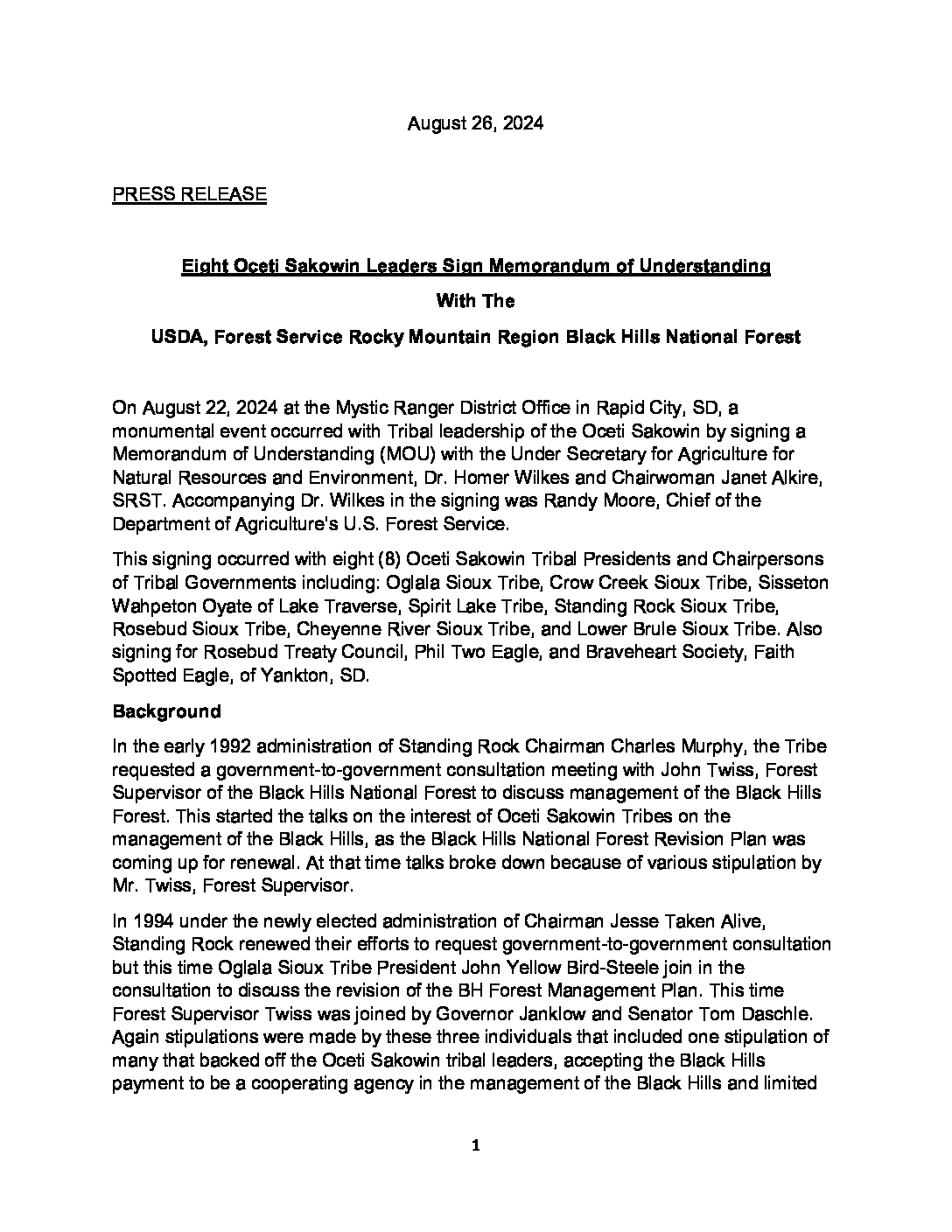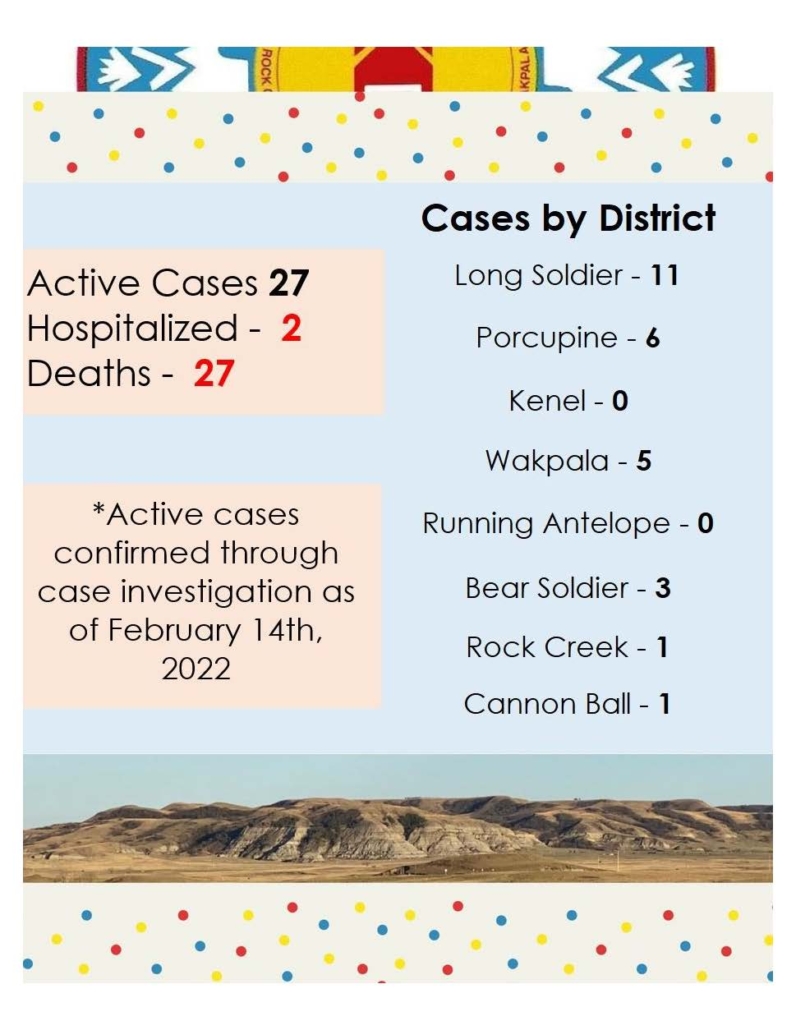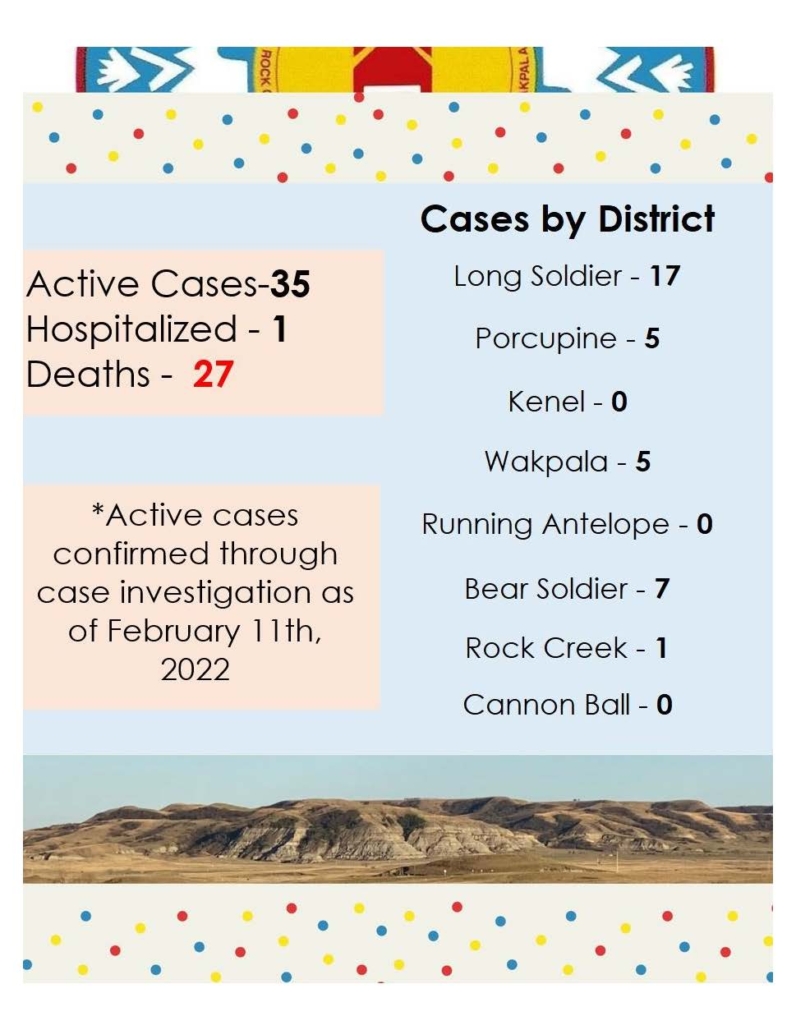August 26, 2024
PRESS RELEASE
Eight Oceti Sakowin Leaders Sign Memorandum of Understanding
With The
USDA, Forest Service Rocky Mountain Region Black Hills National Forest
On August 22, 2024 at the Mystic Ranger District Office in Rapid City, SD, a monumental event occurred with Tribal leadership of the Oceti Sakowin by signing a Memorandum of Understanding (MOU) with the Under Secretary for Agriculture for Natural Resources and Environment, Dr. Homer Wilkes and Chairwoman Janet Alkire, SRST. Accompanying Dr. Wilkes in the signing was Randy Moore, Chief of the Department of Agriculture’s U.S. Forest Service.
This signing occurred with eight (8) Oceti Sakowin Tribal Presidents and Chairpersons of Tribal Governments including: Oglala Sioux Tribe, Crow Creek Sioux Tribe, Sisseton Wahpeton Oyate of Lake Traverse, Spirit Lake Tribe, Standing Rock Sioux Tribe, Rosebud Sioux Tribe, Cheyenne River Sioux Tribe, and Lower Brule Sioux Tribe. Also signing for Rosebud Treaty Council, Phil Two Eagle, and Braveheart Society, Faith Spotted Eagle, of Yankton, SD.
Background
In the early 1992 administration of Standing Rock Chairman Charles Murphy, the Tribe requested a government-to-government consultation meeting with John Twiss, Forest Supervisor of the Black Hills National Forest to discuss management of the Black Hills Forest. This started the talks on the interest of Oceti Sakowin Tribes on the management of the Black Hills, as the Black Hills National Forest Revision Plan was coming up for renewal. At that time talks broke down because of various stipulation by Mr. Twiss, Forest Supervisor.
In 1994 under the newly elected administration of Chairman Jesse Taken Alive, Standing Rock renewed their efforts to request government-to-government consultation but this time Oglala Sioux Tribe President John Yellow Bird-Steele join in the consultation to discuss the revision of the BH Forest Management Plan. This time Forest Supervisor Twiss was joined by Governor Janklow and Senator Tom Daschle. Again stipulations were made by these three individuals that included one stipulation of many that backed off the Oceti Sakowin tribal leaders, accepting the Black Hills payment to be a cooperating agency in the management of the Black Hills and limited decision authority with the Forest Management Plan. Chairman Taken Alive backed off this unacceptable counter offer and this idea of co-management has laid dormant since.
Summary of MOU
Standing Rock has a history with Forest Service within our reservation which Chairwoman Alkire inherited when elected, to seek the return of the National Grasslands within the Standing Rock reservation. Chairwoman Alkire initiated this MOU which came off the Oceti Sakowin’s push to get portions of the Black Hills returned. On October 5th, 2022 Chairwoman Alkire invited Under Secretary Dr. Homer Wilkes and Chief Randy Moore to Standing Rock to discuss the return the National Grasslands within Standing Rock where they both visited the Grasslands with Chairwoman Alkire and Councilmember Paul Archambault. That process was finalized August 22nd creating a Co-Stewardship Agreement with the Tribe for the National Grasslands.
Over two years the Memorandum of Understanding for the management of the Black Hills National Forest was a document that continued to be developed and revised through consultation with the Great Plains tribes. Prior to the signing of the MOU on August 22nd, Oglala Sioux Tribe attorney Mario Gonzalas and Great Plains Chairman’s Association attorney Mark Van Norman continued to meet with Forest Service to get a finalized MOU document for Tribes on the Co-Stewardship of the Black Hills Forest management of unleased lands in the Black Hills.
This gives the Tribes a place within the Black Hills National Forest management plan. This MOU puts the Tribes in a position to help Co-Steward through management of the Black Hills. Under Secretary Dr. Wilkes stated “I would encourage the Tribes to consider signing. Should we not sign this document the funding to implement the conditions in the MOU may be lost with a potential new administration.”
On August 22nd at the Mystic Ranger District (8) Oceti Sakowin Tribes signed the MOU. At the close of the signing Standing Rock Chairwoman Alkire was a holdout to sign because she stated she should take this document to the Tribe. Under Secretary Homer Wilkes when asked the status of the document if not signed, he stated “this is almost two years of consultation with Tribal representatives.”
At the insistence of Tribal Council members Jeff Cadotte, Richard Long Feather and Delray Demery and Tim Mentz Sr., Communications Director, Chairwoman Alkire was urged sign. “This is probably the best document Forest Service has yet produced to date, we have come a long way since the 1990’s to have a document that gives the Tribes a seat at the management table, another chance may never be realized again” stated Tim Mentz Sr. Because of this support of the three Tribal Councilmembers, Chairwoman Alkire joined in signing this precedent setting document.
The MOU states in part:
“The signing of this MOU is in recognition of the Oceti Sakowin Great Sioux Nation Tribes nation-to-nation relationship with the United States of America, traditional indigenous cultural and historical Great Sioux Nation (Lakota, Nakota, Dakota Oyate) connections to the Black Hills National Forest, and continuing treaty rights under the 1851 Treaty with the Sioux Nation and 1868 Treaty with the Great Sioux Nation, the United States of America, acting through the Black Hills National Forest of the United States Department of Agriculture (USDA) Forest Service, and the Great Sioux Nation Tribes.
The Great Sioux Nation Tribes have entered into this MOU to engage in cooperative planning, land and waters conservation, climate protection and remediation, protection of cultural resources and sacred sites, stewardship, fuel reduction, wildfire management, habitat improvement for wildlife benefit including bison and other native species, invasive species intervention, wilderness preservation, sustainable use of natural resources, youth programs, workforce development, exploring options for workforce leases to establish housing and/or work centers in support of Tribal employment, protecting sacred sites, enhancing visitor relations and cultural and historical interpretation in and concerning the Black Hills National Forest.”
The MOU goes on to state important historical information including:
Authorities: Prior to the formation of the United States of America, the Lakota-Nakota-Dakota Oyate was established by our Native People as an independent sovereign nation, with our own national territory – Dakota Makoche. The Great Sioux Nation is vested with inherent sovereignty, rights of self-government and self-determination, treaty rights under the 1851 and 1868 Treaties, including rights to peace, friendship, and commerce with the United States of America, Federal trust responsibility protections, among other things. The USDA Forest Service has authority to engage with the Great Sioux Nation Tribes pursuant to Executive Order 13175, Consultation and Coordination with Tribal Governments, to enter into stewardship agreements with Indian nations under 16 USC §6591(c), §604 of Public Law 108-148 as amended by §8205 of Public Law 113-79, the Agriculture Act of 2014; see Blue Legs v. U.S. Bureau of Indian Affairs, 867 F.2d 1094, 1100 (8th Cir. 1989) (“[t]he existence of a trust duty between the United Sates and an . . . Indian tribes can be inferred from the provisions of a statue, treaty or other agreement, reinforced by the undisputed existence of a general trust relationship between the United States and the Indian people”); Covelo Indian Community v. FERC, 895 F.2d 581 (9th Circ.1990) (all government agencies have “fiduciary” responsibilities to tribes and must always act in the best interests of the beneficiaries).
The United States of America acknowledges Indian nations and tribes as Native Sovereign Nations and Federally Recognized Tribes vested with rights of self- government and self-determination, continuing treaty rights, interests in land, waters, wildlife, wildlife habitat, usufructuary rights, and who value stewardship of nature; the Sioux Nation and the United States of America entered into the 1851 Treaty with the Sioux Nation, etc., and the 1868 Great Sioux Nation Treaty on a sovereign-to-sovereign, nation-to-nation basis to forever “cease” war between the parties, reserve the Great Sioux Nation’s “permanent home” including the Black Hills, reserve unceded Indian lands and hunting grounds, preserve hunting and fishing rights, safeguard traditional cultural practices, and promote self-government.”
The new MOU signed by all parties provides most, if not all, the responsibilities the Oceti Tribes wanted in the 1990’s. This MOU document contains most of the management responsibilities including:
The MOU creates numerous opportunities for the Tribes including, but not limited to:
- Great Sioux Nation Black Hills Forest Stewardship Director. To facilitate effective and well-coordinated participation in this MOU and agreements subsidiary thereto, the Great Sioux Nation Tribes will establish, subject to the availability of funds hereunder, a Great Sioux Nation Black Hills National Forest Stewardship Director compensated at a level equivalent to Forest leadership for five-year terms. The Great Sioux Nation Black Hills National Forest Stewardship Director shall coordinate with the Black Hills National Forest on land use planning and implementation, development of long-term resource management and programmatic goals, collaborative and robust outreach to Tribal Nations, and development of more effective mechanisms for Tribal nation coordination with tribal leaders. Water quality and stream management; biology research, monitoring, and improvement of wildlife habitat.
- Planning for restoration of native bison, elk and other wildlife species habitat, discussion of potential paths towards changes to 36 Code of Federal Regulations 223, 241, and 250 and related USDA Forest Service Regulations to respect Great Sioux Nation hunting, fishing and gathering rights, including 1851 and 1868 treaty rights.
- Integration of Great Sioux Nation Tribes Forest planning values, goals, priorities, and objectives in the Black Hills National Forest Plan revision.
- Pursuant to this MOU and related agreements and grants, the Great Sioux Nation Tribes forestry crews will promote healthy forests and climate remediation.
- Black Hills Traditional Youth Culture and Workforce Development Camps. To develop the Lakota Youth Workforce and create jobs for Tribal youth, with the support of the Black Hills National Forest, and subject to the availability of funds, the Great Sioux Nation Tribes will seek to establish Lakota Culture and Workforce Development Camps to train young Lakota rangers and foresters in Traditional Ecological Knowledge and forestry skills to protect the Black Hills National Forest, medicine plants and other plants, animals and ecosystems, and to potentially provide Forest Service job training and development under workforce development grants and agreements. The Great Sioux Nation Tribes seek to provide meaningful education, employment, and training opportunities for Tribal youth and young adults fostering cultural connections to nature through forestry, reforestation, conservation, climate remediation, invasive species intervention, and nature projects on Forest and Tribal lands (existing youth programs operated by the Black Hills National Forest and the Office of Tribal Relations may provide models for this activity.
Any comments please contact Tim Mentz Sr. Communications at 701-854-8595.


















